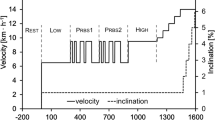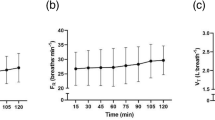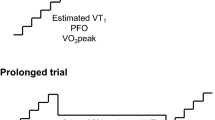Abstract
The purpose of this study was to investigate the effects of endurance training on the ventilatory response to acute incremental exercise in elite cyclists. Fifteen male elite cyclists [mean (SD) age 24.3 (3.3) years, height 179 (6) cm, body mass 71.1 (7.6) kg, maximal oxygen consumption (V˙O2max) 69 (7) ml · min−1 · kg−1] underwent two exercise tests on a cycle ergometer. The first test was assessed in December, 6 weeks before the beginning of the cycling season. The second test was performed in June, in the middle of the season. During this period the subjects were expected to be in a highly endurance-trained state. The ventilatory response was assessed during an incremental exercise test (20 W · min−1). Oxygen consumption (V˙O2), carbon dioxide production (V˙CO2), minute ventilation (V˙ E), and heart rate (HR) were assessed at the following points during the test: at workloads of 200 W, 250 W, 300 W, 350 W, 400 W and at the subject's maximal workload, at a respiratory exchange ratio (R) of 1, and at the ventilatory threshold (Thvent) determined using the V-slope-method. Post-training, the mean (SD) V˙O2max was increased from the pre-training level of 69 (7) ml · min−1 · kg−1 (range 61.4–78.6) to 78 (6) ml · min−1 · kg−1 (range 70.5–86.3). The mean post-training V˙O2 was significantly higher than the pre training value (P < 0.01) at all work rates, at Thvent and at R=1. V˙O2 was also higher at all work rates except for 200 W and 250 W. V˙ E was significantly higher at Thvent and R=1. Training had no effect on HR at all workloads examined. An explanation for the higher V˙O2 cost for the same work rate may be that in the endurance-trained state, the adaptation to an exercise stimulus with higher intensity is faster than for the less-trained state. Another explanation may be that at the same work rate, in the less-endurance-trained state power is generated using a significantly higher anaerobic input. The results of this study suggest the following practical recommendations for training management in elite cyclists: (1) the V˙O2 for a subject at the same work rate may be an indicator of the endurance-trained state (i.e., the higher the V˙O2, the higher the endurance-trained capacity), and (2) the need for multiple exercise tests for determining the HR at Thvent during a cycling season is doubtful since at Thvent this parameter does not differ much following endurance training.
Similar content being viewed by others
Author information
Authors and Affiliations
Additional information
Accepted: 19 October 1999
Rights and permissions
About this article
Cite this article
Hoogeveen, A. The effect of endurance training on the ventilatory response to exercise in elite cyclists. Eur J Appl Physiol 82, 45–51 (2000). https://doi.org/10.1007/s004210050650
Issue Date:
DOI: https://doi.org/10.1007/s004210050650




